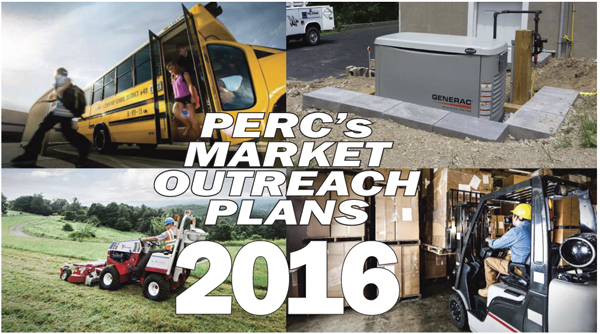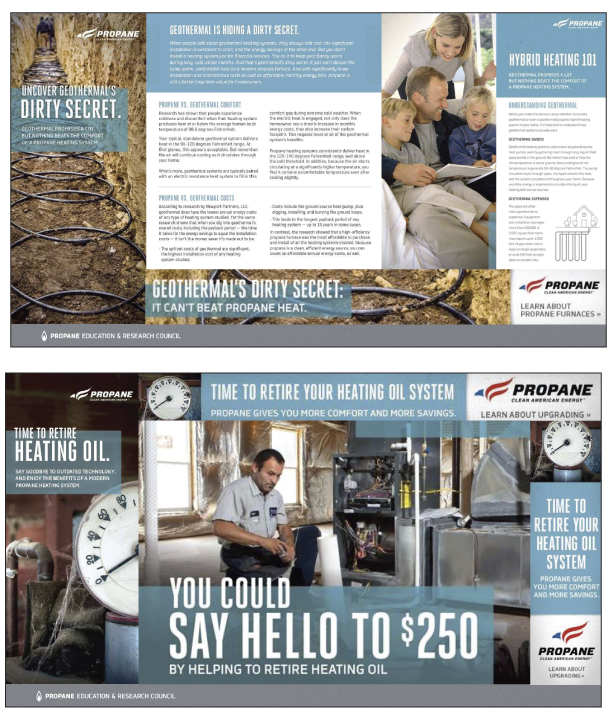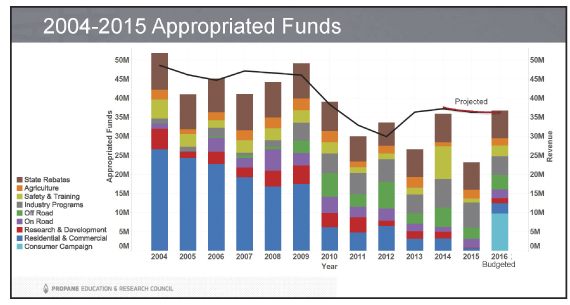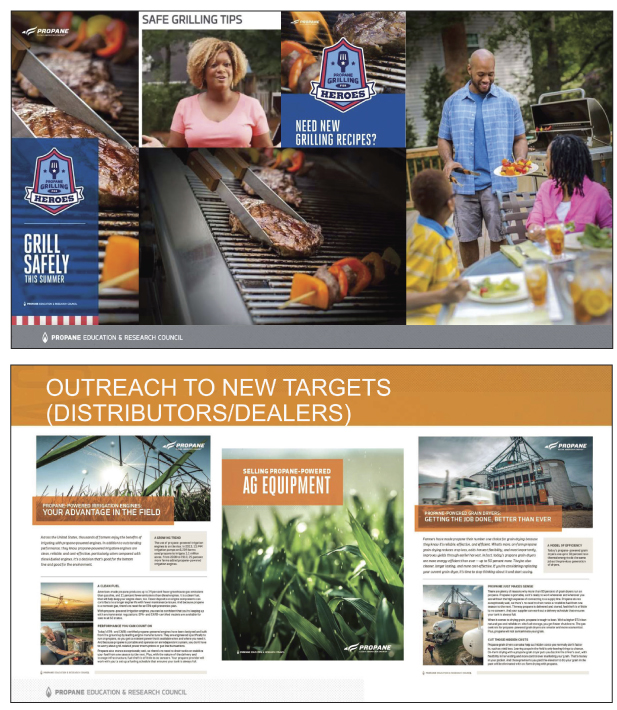Friday, December 11, 2015
New construction, remodels, and switching out products such as water heaters that use other energy sources will be the key areas of focus of the Propane Education & Research Council’s (PERC) 2016 Residential & Commercial Market Outreach Plan, which the council approved at its meeting Nov. 5 and 6 in Boca Raton, Fla. 
The council approved a $47.6-million budget that includes a consumer marketing campaign, ongoing outreach programs aimed at key market sectors, safety and training, and research and development programs. PERC offered some insight on how its outreach programs will work now that its consumer education activity has been restored after a six-year restriction triggered by a Commerce Department price analysis in 2009. After the restriction was lifted earlier this year, a task force appointed by the council recommended “that PERC develop a consumer-facing campaign that communicates the diversity of applications in the home and in the community.” The consumer-facing campaign is budgeted for $9.8 million.
“The budget for next year is designed to take advantage of our newly restored authority to talk to consumers about the benefits of propane while also preserving and promoting our industry’s investment in new propane-fueled appliances, equipment, and vehicles,” PERC president and CEO Roy Willis said, adding that he hopes to unveil the new consumer campaign at the National Propane Gas Association’s Southeastern Convention in April.
Along with the new consumer campaign will be ongoing outreach programs aimed at the residential, commercial, agribusiness, landscape, and autogas markets. The $2.2-million Residential & Commercial Market Outreach Plan will give construction professionals and the propane industry needed information to specify, safely install, and maintain propane appliances, while supporting PERC’s key business objectives to provide commercialization, training, and support in the development of new technology, according to the project description for the 2016 outreach campaign.
For the residential program, targeted campaigns will include the Pull the Plug on Electric Water Heaters program, a campaign to encourage conversion from fueloil to propane, a program to identify opportunities to compete with geothermal, and a “Big Builder Outreach” to communicate with the top 200 builders in the country.
The commercial program will be directed toward decision makers who influence the commercial building process, including construction, specification of new and replacement equipment, and operation of facilities using propane, to opt for and safely use propane.
When the restriction was put in place, the council accelerated its research and development programs and safety and training programs. Willis, in his CEO’s report to the council, noted some council successes over the past few years.
PERC director of agriculture business development Cinch Munson and his team have been busy promoting propane for irrigation products. The drought in California has meant people in that state need new clean engines to pump water into the field. Farmers in the state continue to use propane to heat livestock areas and to dry grain.
“The landscape business is one that…didn’t exist until we started working with engine manufacturers to develop OEM products,” Willis explained. “There were a few conversions in the field, but today we have most of the major commercial mowing manufacturers offering propane products.” In the area of large-scale commercial mowers, Willis noted that about one out of every four new units being put in the field today are propane models.
PERC is addressing challenges to the propane industry, which include the fight against competitors such as geothermal energy. PERC has developed marketing materials such as one titled, “Uncover Geothermal’s Dirty Secret.” Those materials note that a typical standalone geothermal system delivers supply temperatures in the 90°F to 120°F range, which is acceptable, but lower than propane. Geothermal systems are often paired with an electric resistance heat system to fill the gap, increasing the homeowner’s energy costs and carbon footprint. In the Northeast, where Willis says a great opportunity exists to displace fueloil with propane, PERC is working with marketers to develop programs and train builders to do just that. The program offers builders a chance to win a $250 gift certificate by signing up for PERC’s “Time To Retire Heating Oil” program.
“It’s a really important training product to educate people who make and influence energy decisions in the home to go with propane,” Willis stated.
Moving on to discuss the council’s work with school districts, Willis talked about PERC’s efforts to encourage schools to use propane for its lawn care equipment, utility vehicles and other areas in addition to school buses. He mentioned Sanford School Department in Maine, which started out using propane boilers, then went on to use propane for cooking before deciding to use it for fueling its school buses.
Integrating its training program into its market development efforts, the council funded the development of training curriculum for propane autogas maintenance and service technicians. Willis said that the program will roll out early next year to 50 state community colleges and vocational schools.
PERC recently expanded its Pull the Plug on Electric Water Heating campaign to include a consumer education program featuring home improvement television personality Danny Lipford. So far, the council’s safe appliance installation rebate program has resulted in about $5 million in water heater and other appliance rebates, and construction professionals have installed about 19,000 water heaters as a result of the incentives.
Continuing in the area of safety, Willis noted that 40 to 50 million American back yards include a gas grill, and PERC’s safe grilling campaign featured Food Network host Sunny Anderson talking about propane safe grilling techniques. The campaign included a “Grilling for Heroes” program to collect recipes and donations supporting veterans.
He added that a “collateral benefit” of the grilling campaign was that local media channels covered their local heroes who benefitted from the program. “We’ve had a lot of local media coverage that was not part of the initial plan.”
Willis went on to discuss a Propane Autogas Technology Forum, which PERC, the National Renewable Energy Laboratory, and the U.S. Department of Energy’s Clean Cities program hosted earlier this year. “They…were successful in attracting most of the stakeholders and influencers in deployment of propane vehicles and also identifying challenges our industry is going to face going forward,” Willis noted.
National Propane Gas Association (NPGA) president and CEO Rick Roldan provided an update on his association’s activities, stating he was proud of its success in shaping provisions of the 2017 edition of NFPA 58 based on PERC-funded technologies. As an example, he pointed out that NPGA used PERC research to advance the propane industry’s cause related to vehicle impact protection for cylinder exchange cabinets.
Roldan expects that the work of the two organizations in that area will result in the 2017 edition of NFPA 58 containing new requirements permitting metal cylinder exchange cabinets to be installed with no additional protection from vehicle impact.
“That’s a great example of how we can key off of PERC research, leveraged by NPGA and the codes and standards process, that will reduce costs associated with propane installation and thereby help grow gallons,” Roldan said. “Autogas is one of the most promising markets for our industry, and a lot is being done here and internationally. But it’s important for us to recognize that our competitors in the CNG and LNG industries have kind of bested us both here and in Europe when it comes to a uniform autogas standard in North America. We spent a lot of time…on a badly needed update to Chapter 12 of NFPA 58, which is the chapter that deals with autogas, but we’re still going to find ourselves in a situation where there are at least four different sets of North American standards for autogas. We think there’s a need to develop a new single North American code that improves integration between vehicle manufacturers, fuel system designers, and installers. Your investment in this partnership is going to allow us to move forward aggressively on that front.”

He added that NPGA is working with the U.S. Department of Energy on research and development projects involving products such as micro combined heat and power units and direct injection engines. Because of work NPGA, PERC, and other organizations completed in that area, “I believe we’re going to be able in the next 12-month timeframe to announce some pretty significant advances in our desire to create a federal and propane industry R&D partnership.”
Roldan said that the association’s NPGA Reports email, which reaches about 10,000 readers each week, will begin featuring a section highlighting PERC tools for marketers.
PERC also heard a report from its vice chair of producers, Bruce Leonard of Targa Resources, who commented on how the propane supply situation has changed over the past year or so. The rate at which the U.S. has been exporting propane over the last several months equates to about 200 million barrels per year and Leonard said that if it chose to do so, the propane industry could triple the amount of propane it has in storage.

We’ve got a tremendous opportunity before us,” Leonard noted. “If anybody had any sense that there was a limitation to what we could do…because of a limitation on propane, I think the numbers I just put out are a pretty clear indication that’s not the case. So while we’re all being challenged to think about opportunities before us to sell more propane, more gallons to more customers, don’t ever let supply of propane enter your mind as a limitation. In fact, we need to be thinking bigger about the opportunity, about what the increase in production and supply means to us, and how we can take better advantage of that in the future.”

The council approved a $47.6-million budget that includes a consumer marketing campaign, ongoing outreach programs aimed at key market sectors, safety and training, and research and development programs. PERC offered some insight on how its outreach programs will work now that its consumer education activity has been restored after a six-year restriction triggered by a Commerce Department price analysis in 2009. After the restriction was lifted earlier this year, a task force appointed by the council recommended “that PERC develop a consumer-facing campaign that communicates the diversity of applications in the home and in the community.” The consumer-facing campaign is budgeted for $9.8 million.
“The budget for next year is designed to take advantage of our newly restored authority to talk to consumers about the benefits of propane while also preserving and promoting our industry’s investment in new propane-fueled appliances, equipment, and vehicles,” PERC president and CEO Roy Willis said, adding that he hopes to unveil the new consumer campaign at the National Propane Gas Association’s Southeastern Convention in April.
Along with the new consumer campaign will be ongoing outreach programs aimed at the residential, commercial, agribusiness, landscape, and autogas markets. The $2.2-million Residential & Commercial Market Outreach Plan will give construction professionals and the propane industry needed information to specify, safely install, and maintain propane appliances, while supporting PERC’s key business objectives to provide commercialization, training, and support in the development of new technology, according to the project description for the 2016 outreach campaign.

For the residential program, targeted campaigns will include the Pull the Plug on Electric Water Heaters program, a campaign to encourage conversion from fueloil to propane, a program to identify opportunities to compete with geothermal, and a “Big Builder Outreach” to communicate with the top 200 builders in the country.
The commercial program will be directed toward decision makers who influence the commercial building process, including construction, specification of new and replacement equipment, and operation of facilities using propane, to opt for and safely use propane.
When the restriction was put in place, the council accelerated its research and development programs and safety and training programs. Willis, in his CEO’s report to the council, noted some council successes over the past few years.
PERC director of agriculture business development Cinch Munson and his team have been busy promoting propane for irrigation products. The drought in California has meant people in that state need new clean engines to pump water into the field. Farmers in the state continue to use propane to heat livestock areas and to dry grain.
“The landscape business is one that…didn’t exist until we started working with engine manufacturers to develop OEM products,” Willis explained. “There were a few conversions in the field, but today we have most of the major commercial mowing manufacturers offering propane products.” In the area of large-scale commercial mowers, Willis noted that about one out of every four new units being put in the field today are propane models.
PERC is addressing challenges to the propane industry, which include the fight against competitors such as geothermal energy. PERC has developed marketing materials such as one titled, “Uncover Geothermal’s Dirty Secret.” Those materials note that a typical standalone geothermal system delivers supply temperatures in the 90°F to 120°F range, which is acceptable, but lower than propane. Geothermal systems are often paired with an electric resistance heat system to fill the gap, increasing the homeowner’s energy costs and carbon footprint. In the Northeast, where Willis says a great opportunity exists to displace fueloil with propane, PERC is working with marketers to develop programs and train builders to do just that. The program offers builders a chance to win a $250 gift certificate by signing up for PERC’s “Time To Retire Heating Oil” program.

“It’s a really important training product to educate people who make and influence energy decisions in the home to go with propane,” Willis stated.
Moving on to discuss the council’s work with school districts, Willis talked about PERC’s efforts to encourage schools to use propane for its lawn care equipment, utility vehicles and other areas in addition to school buses. He mentioned Sanford School Department in Maine, which started out using propane boilers, then went on to use propane for cooking before deciding to use it for fueling its school buses.
Integrating its training program into its market development efforts, the council funded the development of training curriculum for propane autogas maintenance and service technicians. Willis said that the program will roll out early next year to 50 state community colleges and vocational schools.
PERC recently expanded its Pull the Plug on Electric Water Heating campaign to include a consumer education program featuring home improvement television personality Danny Lipford. So far, the council’s safe appliance installation rebate program has resulted in about $5 million in water heater and other appliance rebates, and construction professionals have installed about 19,000 water heaters as a result of the incentives.
Continuing in the area of safety, Willis noted that 40 to 50 million American back yards include a gas grill, and PERC’s safe grilling campaign featured Food Network host Sunny Anderson talking about propane safe grilling techniques. The campaign included a “Grilling for Heroes” program to collect recipes and donations supporting veterans.
He added that a “collateral benefit” of the grilling campaign was that local media channels covered their local heroes who benefitted from the program. “We’ve had a lot of local media coverage that was not part of the initial plan.”
Willis went on to discuss a Propane Autogas Technology Forum, which PERC, the National Renewable Energy Laboratory, and the U.S. Department of Energy’s Clean Cities program hosted earlier this year. “They…were successful in attracting most of the stakeholders and influencers in deployment of propane vehicles and also identifying challenges our industry is going to face going forward,” Willis noted.
National Propane Gas Association (NPGA) president and CEO Rick Roldan provided an update on his association’s activities, stating he was proud of its success in shaping provisions of the 2017 edition of NFPA 58 based on PERC-funded technologies. As an example, he pointed out that NPGA used PERC research to advance the propane industry’s cause related to vehicle impact protection for cylinder exchange cabinets.
Roldan expects that the work of the two organizations in that area will result in the 2017 edition of NFPA 58 containing new requirements permitting metal cylinder exchange cabinets to be installed with no additional protection from vehicle impact.
“That’s a great example of how we can key off of PERC research, leveraged by NPGA and the codes and standards process, that will reduce costs associated with propane installation and thereby help grow gallons,” Roldan said. “Autogas is one of the most promising markets for our industry, and a lot is being done here and internationally. But it’s important for us to recognize that our competitors in the CNG and LNG industries have kind of bested us both here and in Europe when it comes to a uniform autogas standard in North America. We spent a lot of time…on a badly needed update to Chapter 12 of NFPA 58, which is the chapter that deals with autogas, but we’re still going to find ourselves in a situation where there are at least four different sets of North American standards for autogas. We think there’s a need to develop a new single North American code that improves integration between vehicle manufacturers, fuel system designers, and installers. Your investment in this partnership is going to allow us to move forward aggressively on that front.”

He added that NPGA is working with the U.S. Department of Energy on research and development projects involving products such as micro combined heat and power units and direct injection engines. Because of work NPGA, PERC, and other organizations completed in that area, “I believe we’re going to be able in the next 12-month timeframe to announce some pretty significant advances in our desire to create a federal and propane industry R&D partnership.”
Roldan said that the association’s NPGA Reports email, which reaches about 10,000 readers each week, will begin featuring a section highlighting PERC tools for marketers.
PERC also heard a report from its vice chair of producers, Bruce Leonard of Targa Resources, who commented on how the propane supply situation has changed over the past year or so. The rate at which the U.S. has been exporting propane over the last several months equates to about 200 million barrels per year and Leonard said that if it chose to do so, the propane industry could triple the amount of propane it has in storage.


We’ve got a tremendous opportunity before us,” Leonard noted. “If anybody had any sense that there was a limitation to what we could do…because of a limitation on propane, I think the numbers I just put out are a pretty clear indication that’s not the case. So while we’re all being challenged to think about opportunities before us to sell more propane, more gallons to more customers, don’t ever let supply of propane enter your mind as a limitation. In fact, we need to be thinking bigger about the opportunity, about what the increase in production and supply means to us, and how we can take better advantage of that in the future.”

